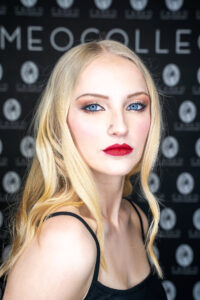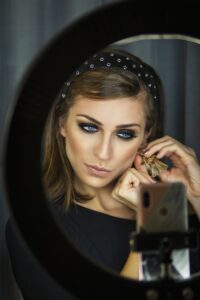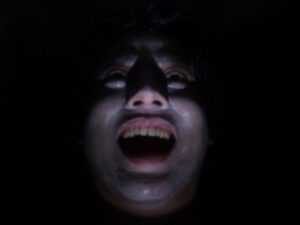Best Lighting: Choosing Light to Apply Makeup
Welcome to Cameo College’s guide on selecting the best lighting for makeup application. As an aspiring makeup artist or beauty enthusiast, understanding the importance of proper lighting is crucial to achieving a flawless makeup look. Whether you’re preparing for a professional makeup studio or perfecting your technique at home, choosing the right lighting conditions can significantly affect the outcome of your makeup application. In this article, we’ll explore the types of light that are ideal for makeup, the impact of lighting on your routine, and how to choose the perfect lighting setup.
Understanding Lighting for Makeup Application

Makeup Lighting – Ring Light
Lighting plays a pivotal role in your makeup routine, influencing how colors appear and how well you apply your makeup. Both natural and artificial light sources have their own advantages and drawbacks, making it essential to understand the different lighting conditions. The best lighting for makeup application allows you to see true colors and details, ensuring your makeup looks impeccable in any setting. At Cameo College, we emphasize the importance of learning how different lighting affects your makeup so you can always look your best.
Importance of Lighting in Your Makeup Routine
Choosing the right lighting is vital for a successful makeup routine. The right light can make colors more vibrant and highlight the precision of your application, while poor lighting can lead to mistakes and an uneven makeup look. Lighting is crucial because it helps reveal the true colors and textures of your makeup products. When you apply makeup under proper lighting, you can ensure that your foundation matches your skin tone, your eyeshadow is blended seamlessly, and your lipstick is applied with precision. Aspiring makeup artists should prioritize learning about lighting to enhance their professional skills.
Types of Light: Natural vs. Artificial
Natural light, such as sunlight, is often considered the best light for makeup application because it provides the most accurate representation of colors. However, natural sunlight is not always available, especially indoors or during certain times of the day. This is where artificial light sources like LED lights and ring lights come into play. LED lights, with their adjustable brightness and color temperature, can mimic natural light and provide a consistent light source ideal for makeup application. Understanding the color rendering index (CRI) of different lights can also help you choose the best lighting to enhance your makeup routine.
How Light Affects Makeup Application
Different lighting conditions can dramatically affect how your makeup appears. Warm lighting, often characterized by yellow light, can make your makeup look warmer and softer, while cool lighting, with blue tones, can create a more vibrant and crisp appearance. Fluorescent lighting, commonly found in many indoor environments, can sometimes distort colors, making it important to adjust your makeup accordingly. Aspiring makeup artists should practice under various lighting setups to master the art of applying makeup in any situation. At Cameo College, we equip our students with the knowledge to choose the best lighting for their makeup needs.
Choosing the Right Lighting

Photo by Apostolos Vamvouras on Unsplash
Color Temperature: What You Need to Know
Color temperature is a critical factor to consider when choosing the best lighting for makeup application. It refers to the warmth or coolness of a light source, measured in Kelvin. For makeup artists, selecting the right color temperature can significantly impact how colors appear on the skin.
| Lighting Type | Color Temperature (Kelvin) |
|---|---|
| Natural Light | 5000K to 6500K |
| Artificial Lighting (e.g., LED) | Adjustable |
Natural light provides a balanced, neutral white light that is ideal for makeup. Artificial lighting sources, such as LED lights, often come with adjustable color temperatures, allowing you to mimic natural sunlight or create specific effects for your makeup routine. Understanding color temperature helps ensure your makeup looks flawless in any lighting condition.
LED Light: Benefits for Makeup Application
LED lights have become a popular choice for makeup artists due to their versatility and energy efficiency. They provide a consistent and adjustable light source that can mimic natural sunlight, making them ideal for makeup application. With the ability to control brightness and color temperature, LED lights allow you to customize the lighting conditions to suit your needs. Additionally, LED lights often have a high color rendering index (CRI), which means they accurately display colors, ensuring your makeup appears true to life. This makes LED lighting a practical and effective solution for both professional makeup studios and at-home setups.
Using Ring Lights for Ideal Lighting
Ring lights are an excellent tool for achieving ideal lighting when applying makeup. Their circular design provides an even distribution of light, reducing shadows and highlighting facial features. This makes them particularly beneficial for close-up work, such as applying eyeliner or blending eyeshadow. Ring lights often come with adjustable brightness and color temperature settings, allowing you to tailor the lighting to the specific requirements of your makeup routine. They are compact and portable, making them a convenient option for both professional makeup artists and beauty enthusiasts looking to enhance their makeup application at home.
The Best Light for Makeup Application
White Light vs. Other Lighting Conditions
When it comes to applying makeup, white light is often considered the best lighting option because it closely resembles natural sunlight, which is known for its ability to reveal true colors. White light provides a balanced spectrum that ensures your makeup appears as intended, without the distortion often caused by other lighting conditions. For example, yellow light can warm up your makeup look, making it appear softer, while blue light might cool down the tones, giving a crisper appearance. At Cameo College, we teach our students to harness the power of white light to enhance their skills and achieve a flawless makeup application.
Brightness Levels: Finding the Right Balance
Brightness is another critical factor in choosing the best lighting for your makeup routine. Too much brightness can wash out colors and make it challenging to see the details of your application, while insufficient light can result in uneven makeup. It’s essential to find a balance that allows for clear visibility without overwhelming the eyes. Adjustable lighting, such as that provided by LED lights, offers the flexibility to customize brightness levels to suit different lighting conditions. At Cameo College, we emphasize the importance of understanding brightness levels to ensure that our students can apply makeup expertly in any environment.
Lighting for Different Makeup Styles
Different makeup styles require varied lighting setups to look their best. Natural and artificial light sources can be used strategically to enhance specific looks. For instance, warm lighting can add a cozy glow to natural makeup styles, while cooler lighting might be preferred for bold, high-fashion looks. When working in professional makeup studios, it’s crucial to adapt the lighting conditions to the desired outcome, ensuring that each style is showcased effectively. At Cameo College, we guide our students in mastering the art of selecting the right lighting for any makeup style, empowering them to create stunning and versatile makeup applications.
Avoiding Poor Lighting Conditions

“A face in the dark” by adibs is licensed under CC BY-NC-ND 2.0
Identifying Poor Lighting for Makeup
Identifying poor lighting conditions is crucial for any aspiring makeup artist aiming to achieve a flawless makeup look. Bad lighting, such as overly dim or harsh fluorescent lighting, can distort colors and shadows, leading to a less-than-ideal makeup application. This can result in uneven foundation, mismatched colors, and an overall unbalanced appearance. It’s essential to recognize these lighting pitfalls and understand how different types of light can impact the final outcome. At Cameo College, we teach our students to identify and avoid poor lighting conditions, ensuring their makeup skills are displayed in the best light possible.
Tips for Improving Lighting Conditions
Improving lighting conditions is essential for achieving the best results in your makeup routine. Start by opting for natural light whenever possible, as it provides the most accurate reflection of colors and textures. If natural sunlight is unavailable, consider using an LED light with adjustable brightness and color temperature settings to replicate the effect of natural light. Incorporating a ring light into your setup can also help distribute light evenly across your face, minimizing shadows. At Cameo College, we guide our students through practical tips for enhancing their lighting conditions to ensure their makeup always looks professional and polished.
Creating an Ideal Lighting Setup
Creating an ideal lighting setup is a key component in mastering the art of makeup application. Whether you are working in a professional makeup studio or setting up at home, the right lighting can make all the difference. Begin by choosing a light source with a high color rendering index (CRI) to accurately display colors. Position your lights to eliminate shadows, using white light or a combination of natural and artificial light to achieve the best results. At Cameo College, we emphasize the importance of setting up an effective lighting environment, empowering our students to apply makeup with confidence and precision.


